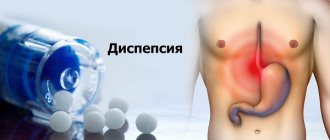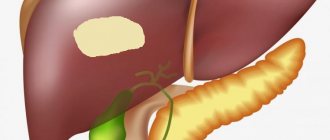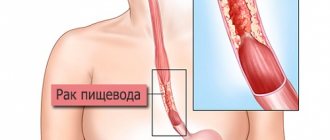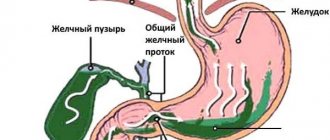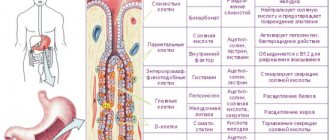Stomach cancer is a disease in which malignant cells form in the tissues of the stomach. Most often, cancer cells are localized in the mucous membrane of the organ and can then grow into other layers. Stomach cancer is quite common. It ranks second in terms of number of cases after lung cancer. Stomach cancer occurs more often in men than in women. It is usually detected after forty years, but younger patients can also get it.
As a rule, stomach cancer is preceded by diseases that can provoke cancer. They can be diagnosed in a patient for decades, even treated by a gastroenterologist, but then a small lump appears - a malignant formation that grows quickly. At first, the tumor affects only the gastric mucosa, then it grows through all layers. Gastric cancer is very active in terms of metastasis. Cancer cells gradually invade the stomach cavity, preventing it from functioning normally. Metastases, which are separated from the tumor itself, travel through the blood or lymph to other organs and settle there. Of course, the human body, with its protective forces, tries to destroy cancer cells, but they divide too quickly and on their own give rise to new tumors. Since the liver takes the lion's share (it pumps and cleanses blood in the body), it becomes the second place where metastases are found. For doctors, this indicator means that somewhere in the body there is a primary source of cancer, and the disease has already entered its final, inoperable stage. A person who has stomach cancer begins to experience pain, he quickly loses weight, and suffers from digestive problems.
Symptoms and signs
Symptoms for this disease are not necessary at all, because small tumors do not show any signs. Most often, patients complain when the tumor interferes with digestion, that is, it has reached a significant size. Typically, patients note a decrease in appetite and an aversion to familiar foods. The body temperature rises to inflammatory - between thirty-seven and thirty-eight. A blood test can indicate anemia and an increase in the erythrocyte sedimentation rate (which indicates the body is struggling).
As the tumor grows in size, symptoms become more obvious. Patients feel heaviness after eating, even after small portions. They are bothered by belching, sometimes nausea with vomiting, and a feeling of fullness. In some cases, constipation occurs. Pain is not always felt in the abdomen; it can also radiate to the back (especially if metastases have occurred in the pancreas). Most often, sharp pain occurs when eating; constant aching indicates a period of tumor growth. If the tumor grows inside and affects blood vessels and tissues, then there may be symptoms of gastric bleeding (black stool due to the presence of blood there, vomiting with blood, sudden weakness, dizziness, cold sweat, slow pulse). If the tumor is located in the upper part near the pylorus, patients may experience difficulty swallowing food. In addition to these symptoms, people with stomach cancer become more irritable, get tired quickly, and have decreased performance.
Causes
- heredity – the risk of developing stomach cancer increases in those people whose relatives also had this disease;
- a certain role is played by the patient’s dietary preferences, abuse of fried, fatty, smoked, salty foods, passion for alcohol, smoking;
- eating food with preservatives;
- the presence of concomitant gastric diseases, such as stomach ulcers, gastritis, polyps;
- surgical interventions - it has been noted that stomach cancer develops more often in those who have undergone any surgery on the stomach;
- the presence of Helicobacter pylori infection, which significantly increases the risk of developing cancer;
- work in hazardous production;
- lack of B vitamins in the body.
If you have such risk factors, you shouldn’t think that you will absolutely develop stomach cancer, but this should be a reason to reconsider your attitude to a healthy lifestyle.
Diagnostics
Medicine has made great strides in diagnosing gastric diseases. Nowadays special devices are used that make it possible to detect the disease in its early stages. These include a gastroscope. This device not only detects cancer, but also any other stomach diseases. A long fiber optic tube is inserted into the stomach cavity. At the end that is inserted into the stomach, there is a small lighting device and a lens. With the help of internal lighting, the doctor can see what is happening in the stomach, how the gastric mucosa is changed, whether there are tumors or ulcerations. This method is the most reliable, since the doctor receives maximum diagnostic access to the patient’s organ. In addition, this diagnostic method in no way harms the patient himself. If the doctor notices a tumor, a biopsy of the suspicious area is immediately performed. The laboratory performs a histological analysis of tissue taken from the stomach to determine the presence or absence of cancer cells in it.
In addition, doctors prescribe additional tests. A blood test also makes it possible to suspect cancer if markers (substances that appear in the presence of tumors of one type or another) are found in the blood.
Before the use of gastroscopy, such diseases were diagnosed using x-rays. Now such methods are used only in those institutions where there is no gastroscope. The patient drinks a special solution, and then during an X-ray examination the doctor sees how it is distributed throughout the stomach, and whether there are places where filling has not occurred. This means that this place is occupied by a tumor. The disadvantage of the method is that only a “filling defect” is determined, and which tumor cannot be determined by quality.
There are other diagnostic methods to help doctors - tomography, ultrasound, diagnostic laparoscopy, but they all have certain disadvantages compared to gastroscopy.
Stages of stomach cancer
Stomach cancer is usually divided into four stages depending on how severely the organ is affected and how far the cancer has spread.
Today the zero stage
, in which cancer cells are detected in the gastric mucosa. Cases of diagnosis of stage zero are very rare in medicine.
First stage
characterized by submucosal tumor invasion and the presence of cancer cells in no more than six lymph nodes. Otherwise, the tumor may be subserous, but the cancer cells have not spread to the lymph nodes or neighboring organs.
At the second stage
the tumor spreads under the mucous membrane. Cancer cells are found in seven to fifteen lymph nodes. Otherwise, the tumor may be in the muscle layer and found in six lymph nodes, but no more. The same stage also characterizes the picture when the tumor has penetrated the outer layer, but has not affected the lymph nodes.
Third stage
– the presence of a tumor in the muscle layer, its spread in no more than fifteen lymph nodes; the presence of a tumor in the outer layer and no more than fifteen lymph nodes; the presence of a tumor in the liver or spleen.
At the fourth stage
Cancer cells can be seen in more than fifteen lymph nodes, or a tumor can be diagnosed in another organ and at least one lymph node.
Treatment of stomach cancer
The only hope for a stomach cancer patient is complete removal of the tumor, which has not yet metastasized. Unfortunately, this situation does not happen to everyone. With metastases, the question is not about cure, but about prolonging the patient’s life. In order to choose the optimal method of cancer treatment, it is also necessary to take into account such factors as the location of the tumor, the stage of development of the disease, the age of the sick person, and the prognosis after surgery.
Today, the only chance to survive or live is only with surgery. If it is timely (that is, metastases have not occurred), then the operation can help cure the patient and give him a chance for many years.
Surgery for a tumor in the stomach is carefully developed, because its tactics depend on where the tumor is located. In most cases, most or all of the stomach is removed.
If a cancerous tumor has grown into the pancreas, intestines, or liver, then it will be necessary to remove part or all of the organ that is affected. In order to prevent relapse of the disease, nearby fatty tissue and lymph nodes are usually also removed - perhaps this is where malignant cells are located.
If distant metastases are detected in a patient, surgery is usually not performed. An exception is only for those cases where the lack of surgery threatens the immediate death of the patient (perforation, bleeding).
The second method after surgery is chemotherapy. Drugs are injected into the body to destroy cancer cells. Typically, chemotherapy for stomach cancer does not give high positive results in terms of cure, but it can prolong the patient’s life for some time. In some cases, chemotherapy can be used after surgery, when the lymph nodes cannot be removed for some reason, but there is a risk of cancer recurrence.
Radiation therapy is used much less frequently, and is done when it is impossible to operate on the patient.
Prevention
In order to avoid stomach cancer, you need to constantly monitor your health, especially your diet. It has been established that the risk of developing cancer is minimal if the stomach does not suffer from diseases such as stomach ulcers, polyps, and gastritis. It is important to be examined by a gastroenterologist every year in order to promptly identify the preconditions for the occurrence of cancer.
Special attention should be paid to the presence of Helibacter pylori in the stomach and the disease should be treated in time.
Giving up bad habits - smoking and alcohol - is of great importance.
For stomach cancer, the doctor prescribes a diet that promotes proper and gentle nutrition. At the same time, the products should be easily digestible; fatty, fried and spicy foods are contraindicated. It is necessary that all necessary substances are present - proteins, fats and carbohydrates, and there is sufficient energy value per day. The consistency of food should be soft, mushy, so as to irritate the walls of the stomach as little as possible.
Prognosis for stomach cancer
Unfortunately, patients with stomach cancer turn to a medical institution at those stages when help becomes problematic. In such cases, only fifteen percent of those who seek help live five years or more. Eleven percent manage to cross the ten-year mark. These are usually younger people who are better able to tolerate the effects of chemotherapy and surgery.
Today, stomach discomfort is a fairly common problem. Unpleasant sensations disrupt the usual way of life. It would seem that nothing hurts, but something always gets in the way. There are many different reasons that lead to discomfort. What to do? How to normalize stomach function?
Causes
Your health condition may deteriorate sharply after eating a large meal. In this case, the stomach swells greatly, belching appears, and gases begin to form. There is a strong burning sensation in the upper abdomen, the patient is bothered by a slight nagging pain, problems with appetite arise, and salivation may increase.
Often not one symptom appears, but several at once. Discomfort may indicate gastroduodenitis, gastritis, and other ailments. Unpleasant sensations begin to intensify after eating or on an empty stomach. Smoking and alcohol have a negative impact on health.
A feeling of discomfort appears after eating fast food, soda, sweets, spicy, salty, fatty, fried foods. To prevent discomfort, try to eat freshly prepared and homemade foods. Avoid nicotine and alcohol; bad habits lead to heartburn, belching, and digestive disorders.
If you take various medications uncontrollably, everything can end in serious pathologies of the stomach and intestines. Quite often discomfort occurs after severe stress. In this case, the mucosal cells begin to shrink and curl. Some people constantly relieve stress with rich food, cigarettes, and alcoholic beverages, which results in serious gastric upsets. Separately, it is worth mentioning about pregnant women. They feel discomfort due to hormonal levels.
Prevention
Is it possible to avoid the pain and unpleasant sensation of a stone in the stomach? Of course it is possible. To do this, you must follow the following preventive recommendations and the feeling of heaviness in the stomach will not haunt you:
- healthy lifestyle;
- correct daily routine and moderate amount of food;
- calm atmosphere during meals;
- fresh food;
- avoid salty, fatty, spicy, flour dishes;
- give up street cuisine (minimize eating fast food);
- quit smoking;
- do not drink alcoholic beverages.
Love vegetables and fruits, drink plenty of fluids (juices, mineral water), switch to lactic acid products (yogurt, kefir). Learn not to worry and face any stressful situation with a smile. After all, everyone knows that nervousness does not solve problems, but only undermines health.
What to do?
In case of a special condition, you can get rid of unpleasant stomach discomfort without the use of medications. It is enough to adhere to a gentle diet.
Try to eat food often, but in small portions. This way the walls of the stomach will not stretch and the mucous membrane will not become inflamed. Prepare dishes in a gentle way - boil, stew, bake food. Fresh vegetables and fruits are best cooked in a slow cooker. Try to drink only non-carbonated clean water - at least 2 liters per day. Eliminate salty, smoked, spicy, fatty foods from your menu. In addition, give up coffee, alcohol, and tobacco. Be sure to check with your doctor about what diet you should follow.
The daily routine is important - rest and wakefulness: sleep about 9 hours a day, try to avoid stress, take a walk in the fresh air every day.
Traditional recipes help a lot. To stimulate gastric function, drink tea with ginger and lemon. Attention! The drink is prohibited for those with high acidity, otherwise their health may worsen.
An infusion of chamomile, chamomile, motherwort, fennel, and caraway quickly relieves pain and discomfort in the stomach. All herbs must be mixed in equal quantities, pour boiling water (a glass), and leave for 20 minutes. Drink half a glass warm.
If, in addition to pain, nausea occurs, use an infusion of a mixture of chamomile, celandine, St. John's wort, and yarrow. Take the drug before meals.
Decoctions and infusions of flax seeds can be used effectively for intestinal and gastric pathologies. You need to take a liter of boiling water and pour in 20 grams of seeds before going to bed. In the morning, strain, drink half a glass on an empty stomach, then take the infusion before meals. The course of therapy is about a month. Prepare fresh infusions daily.
The decoction is easy to prepare. You need to take the seeds (80 grams), boil for 2 hours over low heat, cool slightly, then strain. If you have increased stomach acidity, you need to drink a warm medicine with honey before meals. If the acidity of the stomach is high, honey is dissolved in warm water; if it is low, honey is dissolved in cool water.
Prevention and treatment
Prevention
Overeating is contraindicated to prevent the disease.
Overeating is contraindicated. You need to eat small portions at the same time 5 times a day. Last meal 2 hours before bedtime.- When a stressful situation occurs, try not to eat, but to calm down a little.
- Chew food thoroughly.
- Use only high-quality and fresh products. Avoid products containing preservatives, dyes and stabilizers. Drinks should also be without carbonation and sugar.
- Don't drink alcohol. Alcoholic drinks only harm and aggravate the situation if the disease is already present.
- No smoking.
- Lead an active lifestyle, move a lot, do exercises, play sports.
Treatment
Self-medication is dangerous. The course of treatment is prescribed by a doctor. The gastroenterologist will prescribe the necessary medications and determine the dosage. It can be:
- Enveloping drugs, such as suspensions of “Phosphalugel”, “Maalox”, “Gaviston” and others. They envelop the walls of the stomach, preventing gastric juice and acid in it from irritating the stomach.
- Enzyme preparations: tablets “Pancreatin”, “Creon”, “Mezima” - add enzymes for additional assistance in digesting food.
- Antispasmodic drugs: pills “No-shpy”, “Papaverine” and others. They relax the stomach muscles, relieve pain and spasms.
If your stomach problems are related to a psychological state, then you should make an appointment with a psychologist, attend conversations and, if necessary, take a course of medications to calm you down.
Medicines
After the diagnosis is made, different drugs are prescribed, most often in combination: some drugs help get rid of unpleasant symptoms, others - the cause of the disease. When a person does not tolerate fiber well, the doctor prescribes a laxative.
If the motility of the stomach and intestines is weakened, prokinetics may be prescribed to stimulate peristalsis. For example, Motilium has proven itself to be effective in relieving nausea.
When acidity increases, antacids are a great help. With low acidity, it is necessary to take drugs that stimulate secretion. If there are not enough enzymes in the stomach, you need to undergo a course of therapy - drink Enzistal,.
It is worth paying attention that today there are many different analgesics, but they only relieve symptoms and not the underlying cause. Important! Many medications are incompatible with each other and can lead to severe shock and Quincke's edema. In some situations, the disease worsens.
So, discomfort in the stomach almost always signals a malfunction in the body, so at the first symptoms, immediately get examined. It is quite difficult to make a diagnosis on your own, so first of all, be sure to consult a gastroenterologist. Be healthy!
Discomfortable sensations that occur during the act of swallowing indicate the presence of malfunctions in the functioning of individual organs and systems. A lump in the throat after eating can be accompanied by burning, pressure, pain and suffocation. Pathological symptoms have a destructive effect on the patient’s well-being and quality of life, which often leads to the development of depressive conditions.
Pathological symptoms have a destructive effect on the patient’s well-being and quality of life, which often leads to the development of depressive conditions.
The sensation of a foreign body in the respiratory tract is a consequence of the development of mental or somatic diseases. Concomitant clinical manifestations make it possible to accurately determine the type of disease and, accordingly, choose the optimal way to solve the problem. Ignoring a symptom entails dire consequences, in particular, with the development of infectious diseases, tissue abscess or even blood poisoning cannot be ruled out.
Causes of the disease
All organs in our body have nerve endings that are interconnected. One of the organs predisposed to react to changes in mental background is the stomach. Nerve impulses travel throughout the body, and as a result, some systems malfunction.
Looking at the statistics, you can see that women are much more likely to get the disease than men. Young people over 20 years of age are at risk. There have been cases when gastric neurosis occurred in children and adolescents.
The main reasons that cause digestive system disorders are:
- Conflict within the family or at work.
- Distrust of other people, increased anxiety.
- Lack of sleep, overexertion.
- Shocks and psychological trauma.
- Vegetovascular dystonia.
- Frequent attacks of hysteria and aggression.
- Apathy and depression.
- Fear of some event (exam, acceptance to a high position).
- Excessive sensitivity to negative news.
- Poor and irrational nutrition.
Particular attention should be paid to the development of neurasthenia and improper functioning of the digestive organs in childhood. The child’s psyche is unstable and is constantly exposed to external influences. Sudden fear, physical punishment, tense relationships with parents or constant conflicts in the family can become an impetus for the development of gastrointestinal neurosis.
Lump in throat - what is it?
Patients may interpret the manifestation of discomfort in the respiratory tract differently. Some complain of painful swallowing of saliva, which appears immediately after eating, while others complain of burning, stinging and soreness in the throat area. Some patients claim that a foreign body in the throat prevents them from breathing normally, which leads to panic attacks.
Along with discomfort in the larynx, patients often complain of a number of specific accompanying manifestations, namely:
- nausea;
- stomach pain;
- fever;
- chronic fatigue;
- dizziness;
- moderate chest pain;
- apathy;
- panic attacks.
Based on the complaints described above, it is almost impossible to make an accurate diagnosis. The disease can be determined only after undergoing hardware diagnostics, during which the doctor must perform fibrogastroscopy, evaluate the results of a biochemical blood test and bacterial culture from the patient’s throat.
Lump and heaviness as symptoms of gastritis
Gastritis of the stomach and its causes
If the sensation of a lump - heaviness in the stomach appears frequently and their connection with food intake can be traced, then you should immediately contact a gastroenterologist. Symptoms of gastritis vary depending on the type and area of the lesion. Common to all inflammations are:
- Heaviness in the stomach some time after eating.
- Belching with a sour or stale odor.
- Nausea.
- Pain in the epigastric region.
- Pale skin.
- Weakness.
- Constipation or diarrhea.
Symptoms appear gradually as inflammation develops. Heaviness in the stomach occurs more and more often. When you feel full, you belch and feel like there is a lump in the esophagus. Some of the contents are thrown back. You can roughly determine the area of spread of gastritis by the time interval between eating and the appearance of a coma. If severity occurs after 15–20 minutes, the cause is catarrhal gastritis. The defeat of the antrum is signaled by the feeling of a lump when food reaches the bottom of the organ and is ready to move into the intestines. This occurs approximately 2 hours after the meal.
The reasons for the feeling of a coma may be hidden in advanced forms of gastritis, forming thickening of the walls, polyps. The internal volume of the stomach is reduced. The balance in the production of mucus and enzymes by glandular cells is disrupted. The following types of gastritis are especially dangerous:
- Hyperplastic, with the formation of growths and thickenings due to accelerated cell division.
- Atrophic, when epithelial cells die.
- Polypoid with growths on the walls.
Symptoms of gastritis
If you frequently experience the sensation of a lump, especially if there are no obvious reasons for its formation, you should immediately consult a doctor. Gastritis, which has no symptoms at an early stage of development, quickly becomes acute and can lead to cancer. Causes of stomach disease and frequent lump sensation:
- Poor nutrition.
- Products of dubious quality.
- Fast food.
- Eating large quantities after fasting.
- Spicy and exotic dishes.
- Use of medications, especially painkillers and hormonal drugs.
- Chronic diseases, especially diabetes, pancreatitis.
- Drinking alcoholic beverages.
- Smoking.
- Nervous disorders.
- Great physical activity.
With gastritis with low acidity, the cause of the feeling of heaviness may be a lack of enzymes for processing food. Products are not broken down and remain in the stomach. Their fermentation begins with the release of gases, bloating and colic.
Causes
Why does a lump appear in the throat after eating?
The sensation of a foreign body in the airways is a typical manifestation of more than 30 different diseases. Due to the fact that discomfort appears mainly immediately after eating, the doctor first excludes or confirms the presence of gastroenterological pathologies. In some cases, pharyngeal obstruction is caused by spasm of smooth muscles, tumor formation and psychogenic disorders. If a patient claims that he has a lump in his throat after eating, this may indicate the development of the following diseases:
- gastroesophageal reflux;
- hiatal hernia;
- dysphagia;
- myasthenia gravis;
- aortic aneurysm;
- esophageal diverticulum;
- infectious inflammation;
- "hysterical lump"
Throat stenosis causes hypoventilation of the lungs, which can cause the patient to fall into a coma.
Many patients are in no hurry to contact specialists because they are afraid to discover a tumor or other serious disease that cannot be treated. It should be taken into account that in 93% of cases, timely completion of therapy reduces the risk of developing severe pathologies by 3-4 times. To determine what exactly caused the discomfort in the pharynx, it is worth considering common diseases and their accompanying clinical manifestations.
DO YOU STILL THINK THAT IT IS HARD TO CURE YOUR STOMACH?
Judging by the fact that you are now reading these lines, victory in the fight against diseases of the gastrointestinal tract is not yet on your side.
Have you already thought about surgery? This is understandable, because the stomach is a very important organ, and its proper functioning is the key to health and well-being. Frequent abdominal pain, heartburn, bloating, belching, nausea, bowel dysfunction. All these symptoms are familiar to you firsthand.
But perhaps it would be more correct to treat not the effect, but the cause? We recommend reading the story of Galina Savina, how she cured her stomach. Read the article >>
Everyone has encountered a lump that feels like it has been sitting in the stomach for a long time. For many people, the symptom is explained by physiological reasons and is easily eliminated. But we must not forget that the sensation of a food bolus remaining in the stomach for a long time can be provoked by diseases of the gastrointestinal system.
Diseases characterized by symptoms:
- gastritis;
- prolonged stressful situations;
- binge eating;
- pregnancy;
- poor nutrition.
To identify the exact cause of the unpleasant sensation in the epigastric region (epigastrium), you need to contact a gastroenterologist.
The stomach is a hollow organ that has a powerful muscular frame and is located between the esophagus and the duodenum. From an anatomical point of view, there are 4 parts:
- cardiac, which is adjacent to the esophagus;
- pyloric, which lies closer to the duodenum;
- the body located between the two above-mentioned sections;
- bottom, up and to the left of the cardiac region.
The stomach has anterior and posterior walls, and a greater and lesser curvature.
Thanks to the lower esophageal sphincter, which is a tightly closed ring, food from the stomach is not thrown back into the overlying sections of the gastrointestinal tract.
The shape and size of the organ vary significantly depending on the degree of its filling and the person’s eating habits. With systematic overeating, the walls of the stomach stretch significantly and occupy a significant volume of the abdominal cavity. The capacity ranges from 1.5 to 2.5 liters, taking into account gender (for men the volume is larger).
The wall of the entire digestive system has the same structure; the severity of each individual layer varies. There are:
- mucous membrane, which consists of epithelial and specific cells that perform a digestive function due to the production of gastric juice components;
- submucosa - it ensures the mobility of the mucous membrane and the muscular layer that performs contractile movements;
- the muscular layer, which consists of three layers of smooth muscle: they are located obliquely, circularly and longitudinally;
- serous membrane that covers the outside of the stomach.
The activity of the organ is regulated by nerve plexuses located between the submucosal and muscular layers.
A child's stomach is different from an adult's. In newborns, the organ has a round shape and is located horizontally in the abdominal cavity. After the baby begins to walk, the stomach takes a vertical position. By the age of 7-11, the differences in the anatomical structure of this section of the digestive system between adults and children are erased.
For normal functioning of the stomach, proper regular peristalsis is important. Muscle contractions push the bolus of food (chyme) into the underlying sections of the gastrointestinal tract with a frequency of 3 cycles per minute. Thus, food is digested in the stomach for about an hour, while the processing time depends on the quality of the food. Plant components are broken down faster, meat lingers longer.
There are times when people notice that the food they eat sits in the stomach, as if squeezing the surrounding organs from the inside and even preventing them from breathing fully. This is how you can describe the sensations that arise with this symptom.
The phenomenon is provoked by many factors and usually disappears after their elimination. More often, an incorrect mode of physical activity after eating leads to unpleasant sensations in the epigastric region. Another reason is taking medications, especially those containing iron, as well as frequent exposure to stress.
However, if the gastric mucosa suffers, gastritis (its inflammation) occurs, the feeling of a coma is the initial sign of the disease.
Important! A lump in the stomach is a symptom that is provoked by functional disorders or serves as an indicator of diseases of the digestive system. For treatment, lifestyle correction, drug therapy and traditional medicine are used.
The occurrence of this unpleasant sensation is associated with the following links:
- impaired motility of the gastrointestinal tract;
- incorrect body position after eating and excessive physical activity;
- overstretching of the gastric walls by the volume of food.
All possible reasons that cause the sensation of a lump in the stomach come down to the three mechanisms listed above. The most common factors that lead to this disorder include the following:
- the use of drugs for the treatment of anemia that contain iron, as well as antacids. People taking these groups of medications also complain of heartburn and constipation. After discontinuation of therapy, symptoms disappear;
- playing sports immediately after eating and any excessive physical activity. In this case, after a certain period of time, systematic heartburn may join the feeling of a lump, which indicates the onset of gastroesophageal reflux disease. When performing physical labor, the pressure in the stomach increases significantly, contractile peristaltic movements are not able to push the chyme further and it stagnates. If such an effect lasts for a long time, incompetence of the lower esophageal sphincter occurs and all the contents of the stomach, which have an acidic reaction, are thrown into the overlying section. In this case, a person feels heartburn, hydrochloric acid injures the mucous membrane of the esophagus and, with chronic damage, leads to precancerous conditions and tumors of this part of the gastrointestinal tract;
- dry food and “on the go”;
- severe stress. Negative emotions affect the functioning of the central nervous system, in particular the innervation of the stomach. After an argument during a meal, people notice that they have difficulty swallowing and food lingers longer than usual in one part of the gastrointestinal system. The mechanism of such sensations is a disruption of the innervation of muscle fibers and a slowdown in gastric motility;
- poor nutrition and improper daily routine. Late dinners, the predominance of fatty, fried foods negatively affect the digestion process;
- stomach diseases. In addition to gastritis, a “lump” is felt in tumors of a benign and malignant nature;
- pregnancy. Due to changes in the size of the uterus and pressure in the abdominal cavity, the stomach may malfunction.
If a symptom bothers you systematically, but there are no visible reasons for its appearance, you need to go to the hospital for timely diagnosis and treatment of a possible pathology.
The likelihood of the symptom occurring increases in middle-aged and older people. Those who experience frequent stress and do not watch their diet are also at risk.
Students, due to the constant lack of time for a full meal and love for fast food, also belong to the category of the population that suffers from gastritis.
Dysphagia
Dysphagia is a swallowing disorder that interferes with the normal passage of food and liquid through the esophagus. Pathology can appear as a result of septic inflammation of the trachea, esophagus, larynx and oropharyngeal mucosa. Most often, dysphagia develops against the background of diffuse spasm of the esophagus or the formation of benign and malignant tumors.
Dysphagia is accompanied by specific manifestations, which include:
- periodic cough;
- difficulty swallowing saliva;
- pain when food passes through the esophagus;
- penetration of food particles into the trachea or larynx.
In most cases, patients have difficulty eating only solid foods. Therefore, at the time of undergoing therapy, they adhere to a diet that consists of eating only liquid food.
Treatment
Only after listening to the patient’s complaints, carefully studying the symptoms and research results, can the doctor develop an individual treatment regimen. After the diagnosis has been clarified, most patients have a number of questions. How to remove a stone from the stomach? Do I need to remove it with surgery, or just carry out conservative therapy?
Treatment is prescribed purely individually. It can be complex and include both surgical intervention and drug therapy. The operation can be performed by laparotomy or pancreatectomy. The methods are relevant when attacks occur, accompanied by exhaustion of the body; inflammation develops; the body is exhausted; clear symptoms are observed.
Gastroesophageal reflux
Gastroesophageal (gastroesophageal) reflux is the reflux of duodenal contents into the airways through the esophageal sphincter. Aggressive acids contained in gastric juice penetrate the mucous epithelium of the respiratory tract, which leads to a burn. In this regard, patients complain of a burning sensation, a sensation of a lump in the throat, dry mucous membranes and pain when swallowing saliva.
Reflux may appear immediately after eating or the patient taking a horizontal position. Passive reflux of gastric masses into the oropharynx provokes the appearance of a sour taste in the mouth. The cause of pathological reflux is:
- increased intra-abdominal pressure;
- overweight;
- decreased tone of the esophageal sphincter;
- a sharp decrease in esophageal clearance;
- increased acidity of gastric juice.
Irrational use of medications leads to a decrease in smooth muscle tone, which entails the development of pathological reflux and discomfort in the pharynx.
The development of gastroesophageal reflux is indicated by heartburn, hiccups, frequent regurgitation of food, sensation of a foreign body in the larynx, and moderate pain in the stomach. Untimely elimination of the problem entails ulcerative-erosive damage to the mucous membranes of the airways. In addition, pathological processes in the gastrointestinal tract lead to metaplasia, i.e. replacement of squamous epithelium with columnar epithelium, which greatly increases the risk of developing cancer.
Diagnosis of diseases
At the initial appointment, the doctor will ask questions (when exactly does the pain occur, how much does it hurt, how long has it been bothering you, whether the pain is relieved with antispasmodics) and will conduct a physical examination.
If pressing pain in the stomach appears frequently, then you need to consult a gastroenterologist
Palpation allows the specialist to identify enlargement of the abdominal organs, the presence of fluid, the presence of seals, nodes, tumors in the abdominal wall, and also makes it possible to determine the structure of the palpated tissue. By listening to the abdomen, the doctor will be able to determine whether there is fluid accumulation.
During an external examination, the doctor pays attention to the presence of rashes, scars, pigmentation, hernias, and the severity of the venous network. All this allows us to suggest the cause of the pressing pain in the stomach at the initial appointment.
If the doctor suspects that the pain arises precisely because of a disturbance in the gastrointestinal tract (and not because of a malfunction of the cardiovascular, respiratory or nervous system), then the patient is prescribed blood tests, urine tests, feces and an ultrasound of the abdominal organs, with If necessary, the following studies are carried out:
- X-ray examination of the stomach;
- fibrogastroscopy;
- general analysis of gastric juice;
- analysis of venous blood for enzymes, glucose, Helicobacter, tumor markers.
Hiatal hernia
Hiatal hernia is a sluggish pathology characterized by an expansion of the diameter of the esophageal opening, in which there is a displacement of part of the esophagus into the chest cavity. In the absence of disturbances, the abdominal part of the gastrointestinal tract is located in the abdominal cavity. The development of a hiatal hernia in patients is indicated by the following clinical manifestations:
- hiccups;
- heartburn;
- hoarseness of voice;
- chest pain;
- burning in the throat;
- sensation of a foreign body in the larynx;
- glossalgia (painful tongue);
- dysphagia (difficulty moving food through the esophagus).
A lump in the throat in pregnant women often occurs as a result of increased intra-abdominal pressure caused by the development of the uterus.
While eating, food can get stuck in the esophagus due to weakening of the musculo-ligamentous apparatus of the gastrointestinal tract. Relaxation of the muscles leads to expansion of the opening of the esophageal canal, as a result of which the formation of a hernial orifice is observed.
What is the threat?
Discomfort in the stomach can signal the beginning of a pathological process in the abdominal cavity. If it is observed repeatedly and over a long period, then there is a possibility of an existing disease of any organ of the gastrointestinal tract.
Unpleasant sensations in the stomach can lead to the following diseases:
- pancreatitis;
- stomach ulcer;
- gastritis;
- tumor formations of the stomach and intestines;
- cholelithiasis and others.
The condition of our body largely depends on the correctness of our nutrition. To protect yourself from unpleasant diseases of the abdominal organs, you need to eat fresh and healthy food and properly organize your daily routine.
Author : Petrunina Svetlana Sergeevna, intensive care nurse, specialization: acute poisoning, resuscitation, especially for the site Zhkt.ru
Myasthenia gravis
Myasthenia gravis or false bulbar palsy is a pathology characterized by rapid fatigue of muscle tissue. Autoimmune disorders play a key role in the development of neuromuscular diseases, which lead to damage to the masticatory muscles and disruption of the act of swallowing. Provocateurs of pathological processes are:
- frequent stress;
- emotional stress;
- chronic pathologies;
- decreased immunity;
- irrational use of immunocorrectors.
A sensation of a lump in the throat associated with rapid muscle fatigue is most often diagnosed in adolescent patients.
Against the background of intense physical activity, an increase in fatigue is observed in absolutely all muscle groups. Eating becomes a real problem for patients, since when swallowing food, the muscles of the pharynx practically do not contract. Each meal is accompanied by a change in voice and dysarthria. Constant choking increases the risk of aspiration of fluid and the development of obstruction in the respiratory system.
Aortic aneurysm
Pathological expansion of the aorta in the neck area leads to compression of the muscles of the pharynx, resulting in a sensation of a lump in the larynx. Aortic aneurysm occurs as a result of dystrophic changes in the structure of blood vessels or inflammatory reactions. At the same time, patients report that they feel like there is a lump in the Adam’s apple area, which makes breathing and swallowing difficult.
Most often, aortic aneurysm occurs against the background of development
syphilis, infectious pathologies, atherosclerosis and diabetes mellitus. The dilated part of the vessels creates excess pressure on the muscles of the pharynx, trachea and inferior laryngeal nerve. The development of the disease is indicated by:
- dry cough;
- discomfort when swallowing;
- sensation of a foreign body in the throat;
- hoarseness of voice;
- aching sore throat;
- attacks of suffocation;
- hemoptysis.
Important! A lump in the throat that occurs as a result of dilatation of the aorta can provoke spasm of the pharyngeal muscles and asphyxia.
What to do for stomach pain
When the stomach hurts, a person experiences internal discomfort. Treatment depends on the disease, which can only be identified after a medical examination and consultation with a specialist. To relieve pain, take medications that reduce spasms: No-shpa, Spazmalgon. If the cause is an incorrect diet, medications that block gastric enzymes and have enveloping properties can help: Omez, Almagel.
During pregnancy, spasmodic pain in the abdomen may indicate that contractions are beginning, in which case you need to call an ambulance. If the severity is accompanied by fever, nausea, and poor health, the woman needs an urgent medical examination and consultation with a doctor.
At home, decoctions of chamomile, yarrow, mint, and flax seeds are used for calming. These substances have a calming effect and help relieve spasms.
Regardless of the cause of the discomfort, it is recommended to follow a diet to relieve symptoms and prevent the condition from getting worse. A proper diet will allow you to more accurately determine the need to see a doctor. In case of exacerbation of pain caused by poor nutrition, it is advisable to refrain from eating for at least one day, the body will “rest”. After a hunger strike, you need to gradually expand your diet, starting with soft foods: cottage cheese, yogurt, low-fat sour cream. It is advisable to exclude fried, spicy, smoked foods. Replace meat with steamed fish. Vegetables should be treated with caution; some aggressive substances contained in citrus fruits and other fruits and vegetables can be dangerous.
Esophageal diverticulum
Esophageal diverticulum is a protrusion of the layers of the esophageal wall caused by deformation of the esophagus. Pharyngeal-esophageal diverticula occur against the background of inflammatory reactions in the gastrointestinal tract or decreased tone of the muscular layer of the esophagus. As a rule, a pathology in which a lump may “stand” in the throat area is preceded by gastroesophageal reflux, tuberculosis of the lymph nodes and esophageal candidomycosis.
Symptoms of esophageal diverticula are determined by their location. Pharyngeal-esophageal diverticula are most often accompanied by:
- dysphagia;
- sensation of a lump in the throat;
- painful swallowing;
- burning in the oropharynx;
- hypersalivation (salivation);
- putrid odor from the mouth.
Delayed elimination of pharyngoesophageal diverticula entails the development of phlegmon of the neck.
The disease is treated with medications in a hospital setting under the supervision of a gastroenterologist. During therapy, patients should refrain from eating solid foods in favor of liquid cereals, cream soups, etc. Surgical treatment of pathology is carried out only in the presence of extensive defects, which are accompanied by perforation of the walls of the esophagus, dysphagia and internal bleeding.
Irritable bowel syndrome
Irritable bowel syndrome is a chronic disease characterized by a functional disorder in the small and large intestines.
Signs:
- Discomfort in the intestinal area;
- Bloating.
Causes:
- frequent exposure to stressful situations;
- frequent consumption of foods that produce large amounts of gas in the intestines;
- an abundance of fatty foods and caffeine in the diet;
- lack of dietary fiber in the body.
Treatment of irritable bowel syndrome is based on eliminating the causes of the disease, as well as normalizing lifestyle and nutrition.
Infectious inflammation
Infectious diseases are one of the most common causes of discomfort in the larynx, pharynx and trachea. Inflammatory reactions in the mucous epithelium lead to tissue hypertrophy, resulting in a narrowing of the lumen in the airways. Pathogenic agents provoke not only inflammation, but also allergic reactions, as a result of which the mucous membranes swell, which increases the risk of pharyngeal stenosis.
Burning, painful swallowing and a feeling of a lump in the throat occur with the development of diseases such as:
- pharyngitis;
- rhinorrhea;
- laryngitis;
- tonsillitis;
- sinusitis;
- pharyngomycosis;
- tracheitis;
- laryngotracheitis.
Most colds are accompanied by general symptoms of intoxication - headaches, myalgia, fever, chills, fatigue, etc. Inadequate treatment of pathologies entails chronicity of inflammatory processes, in which morphological changes in tissues are observed.
Classification of bezoars
Phytobezoar
Phytobezoars are the most common. Help for its formation in the stomach is a decrease in the secretory function of the stomach, as well as a violation of the removal of contents from it, poor chewing of food, etc. These bezoars are formed from plant fibers of wild persimmons, grapes, wild plums, figs, bird cherry, etc. The rate of their formation can vary from 1 day to 25 years. Rapid formation occurs from unripe persimmons containing many astringent and resinous substances. Phytobezoars may have
the consistency is soft and loose, and can reach the density found in natural stones. These bezoars can be either single or multiple. The color may be dark brown or green, and the odor may be foul. The dimensions of this type of bezoar vary from a few millimeters to tens of centimeters. As a rule, they are formed in patients who have undergone surgery to remove part of the stomach (resection) or surgery associated with the intersection of the main trunk (or branch) of the vagus nerve passing to the stomach (vagotomy). This happens due to the rapid and unhindered movement of undigested foods into the small intestine. But it is not possible to say for sure about the frequency of occurrence of bezoars in the stomach, because Not all patients who have previously undergone these operations are examined using endoscopic and radiological methods.
Trichobezoar
Trichobezoars form when hair enters the stomach. Most often, this type of bezoar is found in people with a disturbed psyche, those suffering from an irresistible addiction to biting hair, as well as in those whose work involves hair. Trichobezoars often form in children suffering from schizophrenia. Their weight can reach 3.5 kg or more.
Shellacobesoar
Shellacobesoars are formed as a result of the abuse of alcohol varnish, nitro varnish, and polish by persons suffering from alcohol addiction. The thing is that shellac is a natural resin used in the production of varnishes. Polish is an alcohol solution of shellac used in finishing work. So, with the regular consumption of all these liquids, shellac stones are formed in the stomach, which are found mainly in the stomach and never enter the duodenum. This type of bezoar has a brownish-white color and a smooth or slightly rough surface. In cross-section, shellac bezoar has a layered structure and black-brown color. It is also known that such a bezoar can burn, be cut with a knife, and its weight can reach 500 g or more.
Sebobezoar
Sebobezoars occur when animal fats become compacted. Their formation is due to the fact that the melting point of fats (beef, lamb and goat fat) is higher than the temperature inside the stomach. As a result, crystallization of triglycerides occurs with the formation of fat stones.
Pixobesoar
Pixobesoars are found in people who have the habit of chewing var and resin.
Lacto- and hemolactobezoar
Lactobesoars are formed in premature babies who are on a high-calorie artificial diet, which contains lactose and casein. Their formation occurs during the first 2 weeks of a child’s life. Hemolactobezoars disintegrate on their own after gastric lavage, diet correction, and use of breast milk.
Hysterical lump
“Hysterical lump” is a pathology of a neurogenic nature, in which a complex of uncomfortable sensations occurs in the throat area. Patients suffering from mental disorders complain of a lump in the respiratory tract just above the thyroid cartilage. In every third case, patients feel a burning sensation and soreness between the jugular vein and the thyroid cartilage.
Why does a neurogenic lump occur and how to eliminate it? This symptom indicates the presence of mental disorders, which are often caused by stress, panic attacks, hysteria and neurasthenia. Excessive stress on the nervous system leads to disturbances, resulting in spasm of the pharyngeal muscles.
The discomfort increases immediately after eating, as the narrowing of the lower part of the pharynx prevents the normal passage of food through the esophagus. Spasms of the muscles of the larynx and pharynx can be eliminated with the help of sedatives, antipsychotics and antidepressants. Only a neurologist can accurately determine the cause of the appearance of a “hysterical coma”.
Etiological factors
In fact, the feeling that food is sitting in the stomach can occur for many reasons. The main clinicians include the following:
- consumption of certain groups of pharmaceuticals, in particular those containing iron. It is known that the consumption of iron-containing medications affects the functioning of the entire digestive tract. People taking them experience belching, a feeling of a lump in the stomach, constipation, and heartburn. Typically, all of these symptoms disappear as soon as the medications are stopped;
- Often the cause of the feeling of a coma in the stomach is increased physical activity immediately after eating. In this case, we are talking about the fact that a lump can occur if a person ate a heavy meal and immediately went to exercise;
- food consumption on the go. Doctors recommend eating only in a quiet environment, without watching TV;
- Severe stress can also be a cause of this symptom. The reason is that during stress there is a strong negative effect on the nerve fibers of both the central nervous system and the nerve fibers of the stomach. Therefore, if during a quarrel, swearing or conflict a person eats food, then it is possible that he will experience belching, a feeling that food is in the stomach, spasm of the muscles of this organ and other unpleasant symptoms;
- Irrational and unhealthy diet is the most common cause of the feeling of a lump in the stomach. Often this symptom occurs if a person does not eat on time, prefers fried, fatty and spicy foods, and is also addicted to fast food;
- pathologies of the digestive system and stomach in particular. Inflammatory diseases of the stomach can provoke the appearance of such a sensation, but more often the role of a “lump” is a neoplasm of a benign or malignant nature. If such a feeling appears systematically, then you should contact a medical facility as soon as possible for a full diagnosis. After all, if the cause lies in a tumor, the sooner it is identified, the more favorable the prognosis will be.



